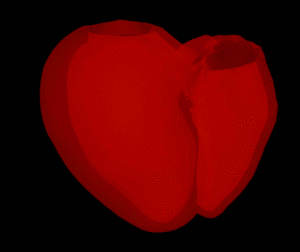What is CardioSync?
CardioSync gives you a chance to pace the heart. Using the controller, you can see how our simulated heart model responds to different lead placements. Try to boost the hearts ability to quickly generate pressure by finding the lead placements that increase dPdtmax – the maximal rate of pressure change.
What is Ventricular Dyssynchrony?
Ventricular dyssynchrony occurs when the normal electrical wave that stimulates the heart is disrupted, causing an abnormal contraction of the muscle tissue. This can occur due to damage of the tissue or blockage of one or more of the electrical ‘super highways’ of the heart, known as purkinje fibres. Disruption of the electrical stimulation of heart muscle affects the timing of contraction making it difficult for the heart to quickly generate blood pressure and drive flow through the cardiovascular system. Approximately one of every three heart failure patients suffers from dyssynchrony.
What is Cardiac Resynchronization Therapy?
Cardiac resynchronization therapy (or CRT) is treatment that aims to restore normal electrical rhythm to the heart. This is achieved through implantation of a device that paces the heart by sending electrical impulses to the muscle tissue through electrical leads placed in the right atrium, right ventricle and left ventricle. By controlling the excitation of the tissue, CRT restores normal ventricular synchrony enabling the effective pumping of the heart.
How can imaging and computers help?
Determining candidates for CRT is often done by examining the electrical rhythm seen in an electrocardiogram. However, the status of a patient’s heart is often variable and can be affected by non-excitable regions of scar. Determining whether the device will be effective and how to optimise the placement of leads in the heart is challenging. Medical imaging can tell us about the size, function and potential structural abnormalities of a patient’s heart. Integrating these with mathematical equations that govern the spread of electrical waves and contraction of muscle in the heart, computational models can be used to predict whether therapy will be effective and how to optimise treatment. To read more about modelling in CRT click here and here.


